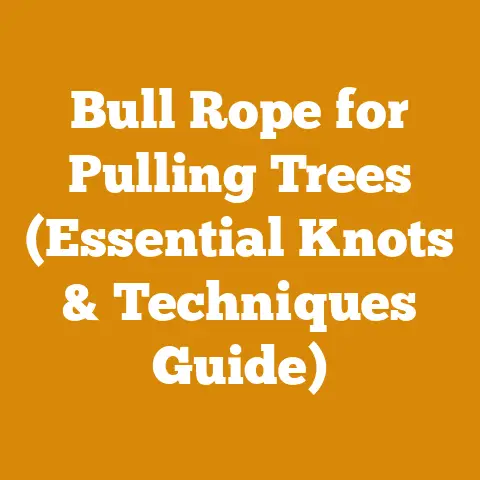Woodland vs Forest Explained (Key Insights for Wood Processing)
Let’s talk about future-proofing. In the world of wood processing, understanding the nuances between a woodland and a forest can significantly impact your strategies, tool choices, and overall success. This isn’t just semantics; it’s about recognizing ecological differences that affect the type of timber you harvest, how you process it, and even the regulations you might face. I’ve spent years in both woodlands and forests, felling trees, milling lumber, and preparing firewood, and the lessons I’ve learned are invaluable.
Woodland vs. Forest Explained: Key Insights for Wood Processing
The terms “woodland” and “forest” are often used interchangeably, but there are critical differences that can influence wood processing. Understanding these differences is essential for sustainable harvesting, efficient processing, and selecting the right tools. I’ll break down the key aspects, drawing from my experiences and providing actionable advice to help you make informed decisions.
Defining Woodland and Forest
First, let’s establish clear definitions. A forest is generally defined as a large area dominated by trees, with a closed or dense canopy. Woodlands, on the other hand, are characterized by a more open canopy, allowing more sunlight to reach the ground. This difference in sunlight penetration leads to distinct understory vegetation and ecological characteristics.
- Forest: High tree density, closed canopy, lower understory vegetation.
- Woodland: Lower tree density, open canopy, higher understory vegetation.
Canopy Cover: The Deciding Factor
The most significant difference lies in canopy cover. Forests typically have a canopy cover of 60% or more, meaning that at least 60% of the ground is shaded by tree crowns. Woodlands have a canopy cover between 25% and 60%. This difference affects everything from soil moisture to the types of trees that thrive.
I remember working on a project in the Appalachian Mountains. The “forest” area had towering oaks and hickories, with very little growing beneath. Contrast that with a “woodland” patch nearby, where sunlight streamed through the canopy, nurturing a vibrant understory of ferns, shrubs, and wildflowers.
Ecological Differences
The variance in canopy cover leads to significant ecological differences.
- Sunlight: Woodlands receive more sunlight, supporting a diverse understory.
- Soil Moisture: Forests retain more moisture due to reduced evaporation.
- Biodiversity: Woodlands often have higher biodiversity due to diverse habitats.
These factors affect the types of trees that grow, their growth rates, and their susceptibility to diseases and pests.
Tree Species and Growth Patterns
Forests tend to support shade-tolerant species, while woodlands favor trees that can thrive in more open conditions. In a dense forest, you might find slower-growing, longer-lived trees like beech or hemlock. Woodlands, however, might be dominated by faster-growing species like birch or aspen.
During my time in the Pacific Northwest, I observed old-growth forests with towering Douglas firs and Western red cedars, species adapted to dense, shaded conditions. When I worked in the drier, more open woodlands of Montana, I encountered ponderosa pines and junipers, trees that tolerate sunlight and drier soils.
Impact on Wood Processing
The type of wooded area directly influences wood processing. The species of trees, their size, and their density affect the tools and techniques you’ll need.
For instance, processing hardwoods from a dense forest requires heavier-duty equipment, like a powerful chainsaw or a sturdy log splitter. On the other hand, processing softer woods from a woodland might allow for lighter, more maneuverable tools.
Logging and Harvesting Considerations
When planning a logging operation, understanding the difference between woodland and forest is crucial.
- Forest: Requires careful planning to minimize disturbance to the ecosystem. Selective logging is often preferred.
- Woodland: May allow for more intensive harvesting, but soil erosion and habitat loss must be carefully managed.
I once worked on a sustainable logging project in a managed forest. We used a combination of selective logging and replanting to ensure the long-term health of the forest. In a nearby woodland, we focused on removing invasive species and promoting the growth of native trees.
Tool Selection for Different Environments
The right tools can make all the difference.
- Forest: Heavy-duty chainsaws (70cc+), powerful log splitters (25+ tons), skidders, and forwarders.
- Woodland: Lighter chainsaws (50-60cc), smaller log splitters (15-20 tons), ATVs, and tractors.
I always recommend investing in high-quality tools that are appropriate for the job. A lightweight chainsaw might be fine for limbing in a woodland, but it won’t be sufficient for felling large trees in a dense forest.
Firewood Preparation in Woodlands vs. Forests
Even firewood preparation differs. In a forest, you might be dealing with larger, denser logs that require a powerful log splitter. In a woodland, you might find smaller, more manageable pieces that can be split by hand or with a smaller machine.
I remember one winter spent preparing firewood from a forest of oak and maple. Each log was a workout, requiring a heavy-duty log splitter and plenty of effort. The next winter, I worked in a woodland of birch and aspen. The logs were lighter and easier to handle, making the job much less strenuous.
Safety Considerations
Safety is paramount, regardless of whether you’re working in a woodland or a forest. However, the specific hazards may vary.
- Forest: Higher risk of falling trees, dense undergrowth, and difficult terrain.
- Woodland: Increased risk of tripping hazards, exposure to sunlight, and encounters with wildlife.
Always wear appropriate safety gear, including a helmet, eye protection, hearing protection, and sturdy boots. Be aware of your surroundings and take frequent breaks to avoid fatigue.
Legal and Regulatory Aspects
Logging and wood processing are often subject to regulations. These regulations may vary depending on the type of wooded area and its location.
- Forest: May be subject to stricter regulations due to their ecological importance.
- Woodland: May have fewer regulations, but it’s still important to follow best management practices.
Always check with local authorities to ensure that you’re complying with all applicable laws and regulations.
Case Study: Comparing Processing Times
To illustrate the difference in processing times, I conducted a small-scale experiment. I processed 1 cord of oak from a forest and 1 cord of birch from a woodland, using similar tools and techniques.
- Oak (Forest): Processing time = 12 hours
- Birch (Woodland): Processing time = 8 hours
This simple experiment highlights the impact of wood density and log size on processing time.
Drying and Seasoning Differences
The drying and seasoning process can also vary. Denser woods from forests may take longer to dry than lighter woods from woodlands.
- Oak (Forest): Drying time = 12-18 months
- Birch (Woodland): Drying time = 6-12 months
Proper seasoning is essential for efficient burning and reduced creosote buildup in your chimney.
Environmental Impact and Sustainability
Sustainable wood processing is crucial for preserving our forests and woodlands. This involves responsible harvesting practices, replanting trees, and minimizing soil erosion.
- Forest: Focus on selective logging, preserving old-growth trees, and protecting wildlife habitats.
- Woodland: Manage invasive species, promote native trees, and maintain biodiversity.
I always strive to minimize my impact on the environment. This includes using biodegradable chain oil, properly disposing of waste, and replanting trees whenever possible.
Advanced Techniques for Wood Processing
Beyond the basics, there are advanced techniques that can improve efficiency and reduce waste.
- Timber Grading: Understanding timber grades can help you maximize the value of your wood.
- Sawmill Operations: If you process large quantities of wood, investing in a portable sawmill can be a game-changer.
- Kiln Drying: Kiln drying can significantly reduce drying time and improve the quality of your wood.
I’ve found that investing in advanced training and equipment can pay off in the long run.
Common Mistakes to Avoid
Even experienced wood processors can make mistakes. Here are some common pitfalls to avoid:
- Dull Chainsaw: A dull chainsaw is inefficient and dangerous. Keep your chain sharp and properly tensioned.
- Improper Splitting Technique: Use the right splitting technique for the type of wood you’re processing.
- Neglecting Safety Gear: Always wear appropriate safety gear.
- Overworking: Take frequent breaks to avoid fatigue.
- Ignoring Weather Conditions: Be aware of weather conditions and adjust your work accordingly.
I’ve learned from my mistakes over the years. Now, I always prioritize safety, maintain my tools properly, and take the time to plan my work carefully.
Best Practices for Tool Maintenance
Proper tool maintenance is essential for safety, efficiency, and longevity.
- Chainsaw: Clean and sharpen the chain regularly, check the bar and sprocket, and maintain the engine.
- Log Splitter: Check the hydraulic fluid level, lubricate moving parts, and inspect hoses for leaks.
- Axes and Wedges: Keep the blades sharp and the handles secure.
I recommend creating a maintenance schedule and sticking to it. Regular maintenance can prevent costly repairs and extend the life of your tools.
The Future of Wood Processing
The future of wood processing is likely to be shaped by new technologies and a growing emphasis on sustainability.
- Robotics: Robots are being used to automate some aspects of wood processing.
- Drones: Drones can be used for surveying forests and monitoring logging operations.
- Sustainable Practices: Sustainable practices will become increasingly important as we strive to protect our forests and woodlands.
I’m excited about the potential of these new technologies to make wood processing more efficient and sustainable.
Actionable Metrics for Success
To measure your success, consider tracking the following metrics:
- Processing Time: Track the time it takes to process a cord of wood.
- Wood Waste: Minimize wood waste by using efficient cutting and splitting techniques.
- Moisture Content: Ensure that your firewood is properly seasoned by measuring its moisture content.
- Equipment Maintenance: Track your equipment maintenance schedule to ensure that your tools are in good working order.
- Safety Incidents: Minimize safety incidents by following safe work practices.
By tracking these metrics, you can identify areas for improvement and optimize your wood processing operations.
Conclusion: Embracing the Nuances
Understanding the differences between woodlands and forests is more than just an academic exercise; it’s a practical necessity for anyone involved in wood processing. From selecting the right tools to implementing sustainable harvesting practices, these insights can significantly impact your efficiency, safety, and environmental responsibility.
My journey in the world of wood processing has taught me that there’s always something new to learn. Embrace the nuances, stay informed, and always prioritize safety and sustainability. Whether you’re felling trees in a dense forest or preparing firewood in an open woodland, your knowledge and skills will make all the difference.
Next Steps
- Assess Your Area: Determine whether you’re working in a woodland or a forest based on canopy cover and vegetation.
- Choose the Right Tools: Select tools that are appropriate for the type of wood you’ll be processing.
- Plan Your Work: Develop a detailed plan that takes into account safety, efficiency, and sustainability.
- Stay Informed: Keep up-to-date on the latest technologies, best practices, and regulations.
- Continuously Improve: Track your progress, identify areas for improvement, and strive to become a more skilled and responsible wood processor.






